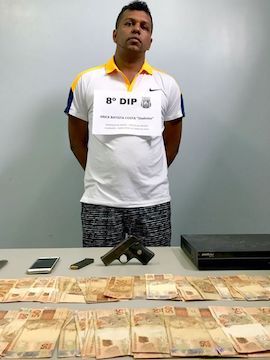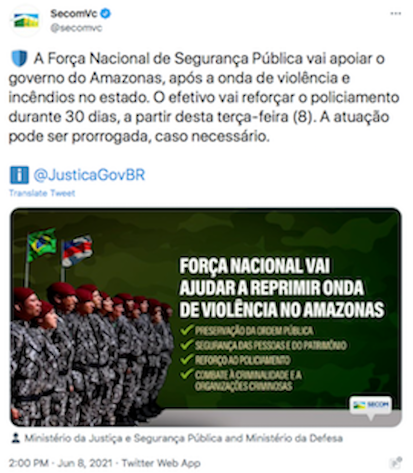Third Generation Gangs Strategic Note No. 40: Força Nacional de Segurança Pública Deployed to Manaus in Aftermath of Comando Vermelho Violence on the Streets
Third Generation Gangs Strategic Note No. 40: Força Nacional de Segurança Pública Deployed to Manaus in Aftermath of Comando Vermelho Violence on the Streets
John P. Sullivan, José de Arimatéia da Cruz, and Robert J. Bunker
An outbreak of criminal attacks on police stations, schools, public spaces, and banks erupted in the aftermath of the killing of a Comando Vermelho (CV or Red Command) leader in a confrontation with the Polícia Militar (PM) do Amazonas in Manaus, Brazil and surrounding cities on Saturday 5 June 2021. The violence started the following day on Sunday 6 June 2021 targeting police, buses, bus stations, schools, public spaces and banks in a series of shootings and arson attacks. Attacks continued through Tuesday 8 June 2021.
Força Nacional de Segurança Pública (National Public Security Force) Vehicle.
Source: Wikimedia Commons, Creative Commons CC BY 2.0
Key Information: Rodrigo Pedroso, “Arson and vandalism sweep Brazilian city of Manaus after death of criminal leader.” CNN News. 6 June 2021, https://www.cnn.com/2021/06/06/americas/manaus-crime-wave-gang-leader-intl-latam/index.html:
Police have been ordered into the streets of the Brazilian city of Manaus, amid a wave of attacks on buses, cars and banks that began on Saturday night and forced the city to halt public transportation and left some residents afraid to leave home.
State officials said criminal gangs in Manaus organized the arson attacks from prison, in retribution for the reported death of one of their leaders during a police raid on Saturday. Images of the weekend’s damage show burned-out buses and bank offices filled with rubble…
…Manaus is a strategic outpost on the international trafficking route of drugs produced in Colombia and Peru. Fighting between rival criminal factions led to massacres of inmates in city jails in both 2017 and 2019.
Key Information: Fabiano Maisonnave, “Manaus vive madrugada de ataques e incêndios após PM matar liderança do tráfico.” Folha de S.Paulo. 6 June 2021, https://www1.folha.uol.com.br/cotidiano/2021/06/manaus-vive-madrugada-de-ataques-e-incendios-apos-pm-matar-lideranca-do-trafico.shtml:
Manaus e três cidades do interior do Amazonas registraram diversos ataques incendiários neste domingo (6) em reação ao assassinato de um líder do tráfico pela Polícia Militar (PM) . Integrantes da facção criminosa CV (Comando Vermelho) depredaram, entre outros alvos, 15 ônibus do transporte público municipal de Manaus, 3 agências bancárias, 2 viaturas policiais e 1 ambulância do Samu (Serviço de Atendimento Móvel de Urgência).[1]
Key Information: “Onda de ataques em Manaus: o que se sabe e o que ainda falta esclarecer.” G1 (Globo). 7 June 2021, https://g1.globo.com/am/amazonas/noticia/2021/06/07/onda-de-ataques-em-manaus-o-que-se-sabe-e-o-que-ainda-falta-esclarecer.ghtml:
O Amazonas sofreu uma onda de ataques violentos entre os dias 6 e 8 de junho, por parte de grupos criminosos. Diversos veículos foram incendiados e prédios públicos depredados, como delegacias. Também houve atentados em pelo menos nove cidades do interior…
…Os ataques ocorreram em Manaus e nove cidades do interior: Carauari, Caapiranga, Careiro Castanho, Iranduba, Manacapuru, Parintins, Rio Preto da Eva, Anori e Itapiranga.
Na capital, os homens atearam fogo em pelo menos 21 veículos, sendo 14 ônibus do transporte coletivo e duas viaturas policiais. Na maioria dos atentados, eles usaram coquetel molotov: uma recipiente cheio de combustível com pavio no gargalo…
…O explosivo também foi jogado em prédios públicos, como agências bancárias, estações de ônibus e um distrito de obras da prefeitura de Manaus, com ataques registrados em todas as suas regiões.[2]
Key Information: João Bosco Cyrino, “Caos no Amazonas: guerra entre facção criminosa e polícia se soma à tragédia da covid.” Brasil de Fato. 8 June 2021, https://www.brasildefato.com.br/2021/06/08/caos-no-amazonas-guerra-entre-faccao-criminosa-e-policia-se-soma-a-tragedia-da-covid:
O estado do Amazonas vive uma nova onda de violência desde o último sábado (5), após a morte de um membro importante da facção criminosa carioca Comando Vermelho (CV) em confronto com a Polícia Militar do Amazonas. Tanto a capital como o interior sofreram ataques e incêndios a delegacias, escolas, praças, obras públicas e agências bancárias, retaliações à morte de Erick Batista da Costa, conhecido como Dadinho. A violência criminosa chega como mais um fator para formar a “tempestade perfeita” que despenca sobre a população.
Esta é a maior demonstração de força da facção no Amazonas desde 2019, quando assumiu o controle do crime organizado no estado, após uma guerra de dois anos com a facção Família do Norte.
Nas últimas 48 horas, boa parte do comércio, escolas e serviços públicos — incluindo a vacinação contra a Covid-19 — foram suspensas por falta de capacidade dos governos estadual e municipais de coibir atos de violência. A população vive o desespero de não saber como terminará esse embate entre polícia e CV.
“Com a chegada do Comando Vermelho, deixamos de ter o bandido conhecido da comunidade e vivemos com traficantes que vieram de fora”, conta um arquiteto de 63 residente em um dos bairros controlados pelo CV em Manaus, que pediu anonimato por temer represálias. Ele afirma que “a Família do Norte” tinha parentes e amigos na região, por isso a situação não chegava ao ponto de violência atual. “Hoje, convivemos com o crime numa zona de guerra sem valor sentimental ou senso de comunidade, com bandidos que só recebem ordens vindas do Rio de Janeiro”.[3]
Key Information: Chris Dalby, “Could Militia-Red Command Feud Explain Manaus Violence in Brazil?” InSight Crime. 9 June 2021, https://insightcrime.org/news/could-militia-red-command-feud-explain-manaus-violence-in-brazil/:
The ire of the Red Command came after one of its leaders in the Amazon region, Erick Batista, alias “Dadinho,” was killed by police near Manaus on June 5.
The violence was “motivated by the death of a trafficker known as Dadinho and intelligence showed that the order [for the violence] came from within prisons,” said the secretary of public security for Amazonas state, Louismar Bonates, at a press conference.
However, [an uncorroborated] letter reportedly sent by the CV to the press provided a different version of events. In it, the gang alleged that Batista and Bonates knew each other and that a pact between police and the CV had been reached.
The letter accused Bonates of being a part of a militia-like organization within Amazonas’ military police. The group alleged that Bonates met with Batista 40 days before his death, demanding the gang member pay him a bribe of 600,000 reais ($120,000) in cash, as well as a quantity of gold. It also listed a number of alleged criminal acts involving Bonates, including bribery, extortion and drug trafficking.
Key Information: “Ministério da Justiça e Segurança Pública autoriza uso da Força Nacional no Amazonas.” Ministério da Justiça e Segurança Pública (MJSP), Governo Federal do Brasil. 8 June 2021, https://www.gov.br/mj/pt-br/assuntos/noticias/ministerio-da-justica-e-seguranca-publica-autoriza-uso-da-forca-nacional-no-amazonas:
O ministro da Justiça e Segurança Pública, Anderson Torres, autorizou o emprego da Força Nacional de Segurança Pública (FNSP) em apoio ao governo do Amazonas, após o estado sofrer uma onda de violência. A Portaria MJSP nº 254/2021 foi publicada nesta terça-feira (8), no Diário Oficial da União. Inicialmente, o emprego da Força Nacional será de 30 dias, a partir de hoje.
De acordo com o ministro, a medida visa preservar a ordem pública e da segurança das pessoas e do patrimônio. “A Força Nacional de Segurança Pública vai reforçar o policiamento no enfrentamento da crise provocada pela onda de violência e incêndios na região. O Ministério da Justiça e Segurança Pública está atento para combater a criminalidade, especialmente de organizações criminosas. Essas medidas exigem uma atuação integrada e coordenada das forças de segurança”, destacou o ministro Anderson Torres.
A atuação do efetivo da Força Nacional poderá ser prorrogada, caso seja necessário. A operação tem apoio logístico do estado demandante, que deverá dispor da infraestrutura necessária aos agentes de segurança pública.[4][5]
Ministério da Justiça e Segurança Pública autoriza uso da Força Nacional no Amazonas
(MJSP – Ministry of Justice and Public Security authorizes use of the Força Nacional in Amazonas.) Source: MJSP, 8 June 2021.
Third Generation Gangs Analysis
Starting Saturday 5 June 2021, the Comando Vermelho (CV – Red Command) initiated a series of attacks thoughout the Manaus region in Amazonas. The attacks were part of a broader conflict with the Polícia Militar do Amazonas (Amazonas Military Police or PM) in retaliation for the death of Erick Batista da Costa, known as ‘Dadinho.’ Dadinho was a CV leader killed in a confrontation with the PM’s special ROCAM unit (Rondas Ostensivas Cândido Mariano), a tactical response and saturation patrol enforcement capability.[6]

Erick Batista, “Dadinho” and Items Seized During a 2017 Warrant Arrest
Source: Polícia Civil do Estado do Amazonas (Amazonas State Civil Police)
http://www.policiacivil.am.gov.br/noticia/id/6953/ano/2017/.
Attacks—both shootings and arsons—were directed against police and public infrastructure, including buses, bus stations, public spaces, schools, and banks in Manaus and nine additional cities through out the Manaus metro region. These additional cities included: Carauari, Caapiranga, Careiro Castanho, Iranduba, Manacapuru, Parintins, Rio Preto da Eva, Anori, and Itapiranga. Covid-19 testing, and vaccinations were suspended during the days of armed confrontations.
The Força Nacional de Segurança Pública (FNSP or National Public Safety Force), a specially trained response force for civil strife was deployed for 30 days to stabilize the situation.[7]

Força Nacional de Segurança Pública Deployed to Amazonas [8]
Source: Presidency of the Republic of Brasil. Twitter. 8 June 2021, https://twitter.com/secomvc/status/1402370003467477001?s=20.
The CV—a gang from Rio de Janeiro—is an example of the prison-street gang complexes found in Brazil’s prisons and on the streets where gangues (gangs), facções (factions), and milicias (militias) compete with each other and the state for territorial control, political power, and profit.[9] The criminal contest for power extends from the prisons to the streets and vice versa. In this recent contest, the specter of corrupt police links with milicias has been raised but is not yet substantiated.[10] The competition for power between gangues and milicias, however, is well-documented.[11]
Sources
João Bosco Cyrino, “Caos no Amazonas: guerra entre facção criminosa e polícia se soma à tragédia da covid.” Brasil de Fato. 8 June 2021, https://www.brasildefato.com.br/2021/06/08/caos-no-amazonas-guerra-entre-faccao-criminosa-e-policia-se-soma-a-tragedia-da-covid.
Chris Dalby, “Could Militia-Red Command Feud Explain Manaus Violence in Brazil?” InSight Crime. 9 June 2021, https://insightcrime.org/news/could-militia-red-command-feud-explain-manaus-violence-in-brazil/.
Fabiano Maisonnave, “Manaus vive madrugada de ataques e incêndios após PM matar liderança do tráfico.” Folha de S.Paulo. 6 June 2021, https://www1.folha.uol.com.br/cotidiano/2021/06/manaus-vive-madrugada-de-ataques-e-incendios-apos-pm-matar-lideranca-do-trafico.shtml.
“Ministério da Justiça e Segurança Pública autoriza uso da Força Nacional no Amazonas.” Ministério da Justiça e Segurança Pública (MJSP), Governo Federal do Brasil. 8 June 2021, https://www.gov.br/mj/pt-br/assuntos/noticias/ministerio-da-justica-e-seguranca-publica-autoriza-uso-da-forca-nacional-no-amazonas.
Rodrigo Pedroso, “Arson and vandalism sweep Brazilian city of Manaus after death of criminal leader.” CNN News. 6 June 2021, https://www.cnn.com/2021/06/06/americas/manaus-crime-wave-gang-leader-intl-latam/index.html.
Endnotes
[1] In English, the title reads: “Manaus lives in the middle of the night of attacks and fires after the PM kills the trafficking leader.” The text reads: “Manaus and three cities in the interior of Amazonas registered several arson attacks this Sunday (6) in reaction to the murder of a drug lord by the Military Police (PM). Members of the criminal faction CV (Comando Vermelho) [Red Command] depredated, among other targets, 15 public transport buses in Manaus, 3 bank branches, 2 police vehicles and 1 SAMU (Mobile Emergency Care Service) ambulance.”
[2] In English, the title reads: “Wave of attacks in Manaus: what is known and what remains to be clarified.” The text reads: “Amazonas suffered a wave of violent attacks between the 6th and 8th of June by criminal groups. Several vehicles were set on fire and public buildings, such as police stations, were destroyed. There were also attacks in at least nine cities in the interior”…“The attacks took place in Manaus and nine cities in the interior: Carauari, Caapiranga, Careiro Castanho, Iranduba, Manacapuru, Parintins, Rio Preto da Eva, Anori and Itapiranga.”… “In the capital, the men set fire to at least 21 vehicles, including 14 public transport buses and two police vehicles. In most of the attacks, they used Molotov cocktail: a container full of fuel with a wick in the neck.”…“The explosive [incendiary device] was also dropped on public buildings, such as bank branches, bus stations and a construction district of the Manaus city hall, with attacks registered in all its regions.”
[3] In English, the title reads: “Chaos in Amazonas: war between criminal faction and police adds to the tragedy of Covid.” The text reads: “The state of Amazonas has been experiencing a new wave of violence since last Saturday (5), after the death of an important member of the Rio de Janeiro criminal gang Comando Vermelho (CV) in a confrontation with the Amazonas Military Police. Both the capital and the interior suffered attacks and fires at police stations, schools, squares, public works and bank agencies, retaliation for the death of Erick Batista da Costa, known as Dadinho. Criminal violence comes as one more factor to form the “perfect storm” that descends on the population.”…“This is the biggest show of strength by the faction in Amazonas since 2019, when it took control of organized crime in the state after a two-year war with the Família do Norte faction.”…“In the last 48 hours, a large part of businesses, schools and public services—including vaccination against Covid-19—were suspended due to the lack of capacity of state and municipal governments to curb acts of violence. The population lives the despair of not knowing how this clash between police and CV will end.”…“With the arrival of the Comando Vermelho, we no longer have the bandit known to the community and we live with drug dealers who came from outside”, says a 63-year-old architect who lives in one of the neighborhoods controlled by CV in Manaus, who requested anonymity for fear of reprisals. He says that ‘the Northern Family’ had relatives and friends in the region, so the situation did not reach the point of current violence. ‘Today, we live with crime in a war zone with no sentimental value or sense of community, with bandits who they only receive orders from Rio de Janeiro.’”
[4] In English, the title reads: “Ministry of Justice and Public Security authorizes use of the Força Nacional [National Force] in Amazonas.” The text reads: “The Minister of Justice and Public Security, Anderson Torres, authorized the use of the Força Nacional de Segurança Pública (FNSP) [National Public Security Force] in support of the government of Amazonas, after the state suffered a wave of violence. MJSP Ordinance No. 254/2021 was published this Tuesday (8), in the Official Gazette of the Union. Initially, the use of the National Force will last 30 days, starting today.”…“According to the minister, the measure aims to preserve public order and the security of people and property. ‘The National Public Security Force is going to reinforce policing to face the crisis caused by the wave of violence and fires in the region. The Ministry of Justice and Public Security is keen to fight crime, especially from criminal organizations. These measures require an integrated and coordinated action by the security forces,’ highlighted Minister Anderson Torres.”…“The performance of the Força Nacional [National Force] may be extended, if necessary. The operation has logistical support from the requesting state, which must have the necessary infrastructure for public security agents.”
[5] See “PORTARIA MJSP Nº 254, DE 7 DE JUNHO DE 2021.” Diário Oficial da União. 7 June 2021, https://www.in.gov.br/en/web/dou/-/portaria-mjsp-n-254-de-7-de-junho-de-2021-324124535.
[6] A state-level PM special enforcement response force. See “ROCAM” at Polícia Miltar do Amazonas, https://pm.am.gov.br/portal/pagina/rocam.
[7] The Força Nacional de Segurança Pública (FNSP or National Public Security Force) is a composite force comprised of specially trained officers from Brazil’s state Polícia Militar (PM or military police forces). They are a response for riots, public order, and civil strife. There force structure includes police, firefighters, and criminalists (forensic investigators). See “Saiba mais sobre a atuação da Força Nacional de Segurança Pública,” Ministério da Justiça e Segurança Pública, https://www.justica.gov.br/news/collective-nitf-content-1546630482.88.
[8] “A Força Nacional de Segurança Pública vai apoiar o governo do Amazonas, após a onda de violência e incêndios no estado. O efetivo vai reforçar o policiamento durante 30 dias, a partir desta terça-feira (8). A atuação pode ser prorrogada, caso necessário.” In English, the text reads: “The National Public Security Force will support the government of Amazonas, after the wave of violence and fires in the state. The effective will reinforce the policing for 30 days, starting this Tuesday (8). The performance can be extended if necessary.”
[9] See, for example, Guilherme Damasceno Fonseca, “The Use of Terrorist Tools by Criminal Organizations: The Case of the Brazilian Primeiro Comando da Capital (PCC).” Perspectives on Terrorism. Vol. 14, no. 4 (August 2020): pp. 64-82, https://www.jstor.org/stable/26927664?seq=1#metadata_info_tab_contents and John P. Sullivan, “The Challenges of Territorial Gangs: Civil Strife, Criminal Insurgencies and Crime Wars.” Revista do Ministério Público Militar (Brazil), Edição n. 31. November 2019, https://www.academia.edu/40917684/The_Challenges_of_Territorial_Gangs_Civil_Strife_Criminal_Insurgencies_and_Crime_Wars.
[10] Chris Dalby, “Could Militia-Red Command Feud Explain Manaus Violence in Brazil?” InSight Crime. 9 June 2021, https://insightcrime.org/news/could-militia-red-command-feud-explain-manaus-violence-in-brazil/.
[11] This is especially the case in Rio de Janeiro. See John P. Sullivan, José de Arimatéia da Cruz, and Robert J. Bunker, “Third Generation Gangs Strategic Note No. 32: Militias (Milícias) Surpass Gangs (Gangues) in Territorial Control in Rio de Janeiro.” Small Wars Journal. 26 October 2020, https://smallwarsjournal.com/jrnl/art/third-generation-gangs-strategic-note-no-32-militias-milicias-surpass-gangs-gangues.
For Additional Reading
John P. Sullivan, José de Arimatéia da Cruz, and Robert J. Bunker, “Third Generation Gangs Strategic Note No. 32: Militias (Milícias) Surpass Gangs (Gangues) in Territorial Control in Rio de Janeiro.” Small Wars Journal. 26 October 2020.
John P. Sullivan, “The Challenges of Territorial Gangs: Civil Strife, Criminal Insurgencies and Crime Wars.” Revista do Ministério Público Militar (Brazil), Edição n. 31, November 2019.
John P. Sullivan, Robert J. Bunker, and José de Arimatéia da Cruz, “Third Generation Gangs Strategic Note No. 12: Brazilian Prison Gangs Attack Civil Infrastructure in Fortaleza and Other Cities in Ceará State.” Small Wars Journal. 17 January 2019.
Paul Rexton Kan, “Busted: The Micropower of Prisons in Narco States.” Small Wars Journal. 5 December 2016.







